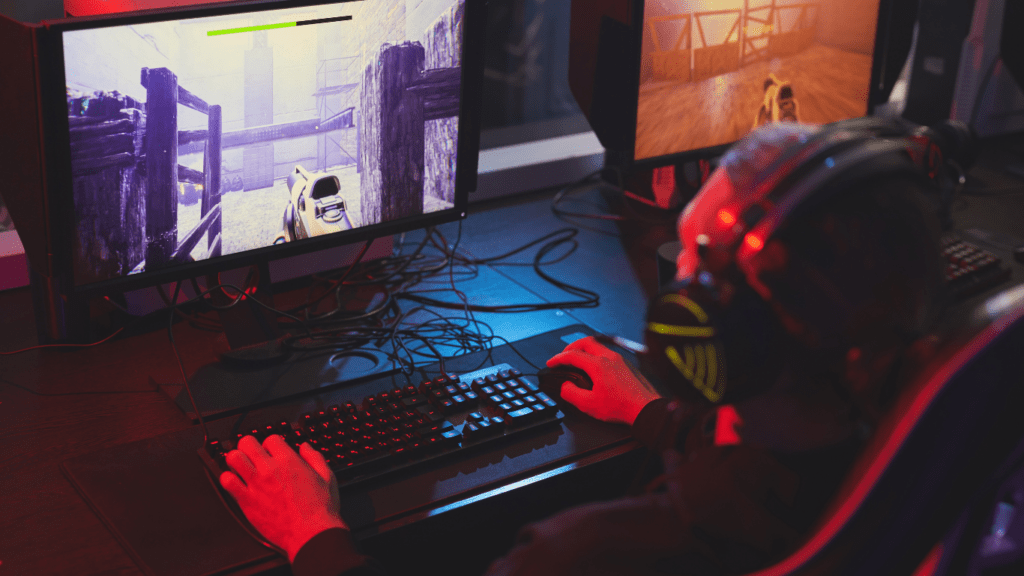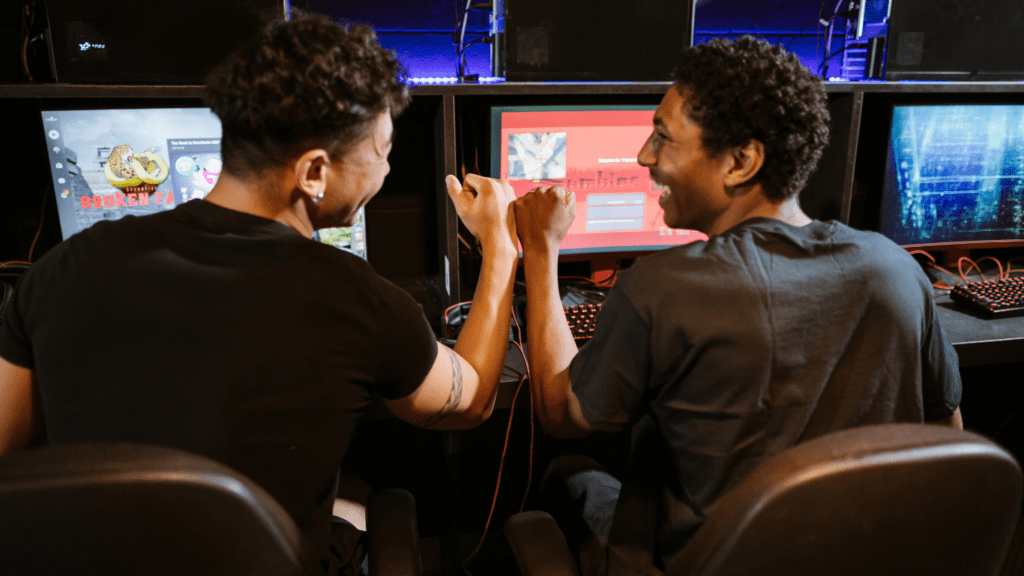Understanding the Basics of E-Sports Training
Training like a pro e-sports player involves more than just hours in front of a screen. It requires understanding the foundational aspects of e-sports training.
What Makes E-Sports Different?
E-sports combines physical skills with mental agility. Unlike traditional sports, e-sports relies heavily on quick reflexes, precise hand-eye coordination, and strategic thinking. Games like “League of Legends,” “CS:GO,” and “Dota 2” require different training regimens. In e-sports, success depends on mastering game mechanics, understanding meta-strategies, and staying updated with patches and changes.
The Importance of Mindset
A strong mindset is crucial for e-sports players. Mental resilience helps manage stress during high-stakes matches and long training sessions. Players must cultivate a growth mindset to continuously improve and adapt to new challenges. Techniques like mindfulness meditation, positive self-talk, and visualization enhance focus and performance. Maintaining a healthy lifestyle and getting adequate rest supports mental well-being, which directly impacts gameplay.
Understanding these basics sets the stage for more advanced training techniques, helping players develop a holistic approach to e-sports proficiency.
Setting Up Your Training Environment
To train like a pro e-sports player, it’s essential to set up an optimal training environment. This involves choosing the right equipment and creating a distraction-free zone.
Choosing the Right Equipment
Having the right equipment significantly impacts performance. Invest in a high-refresh-rate monitor, preferably 144Hz or higher, for smoother visuals. Use a mechanical keyboard for faster response times and customizable keys. Select an ergonomic mouse that fits your hand size and grip style to minimize strain during long sessions. High-quality headsets ensure clear communication with teammates and precise in-game audio cues. Examples include Logitech G Pro X, Razer DeathAdder V2, and HyperX Alloy FPS Pro.
Creating a Distraction-Free Zone
A distraction-free zone enhances focus and training effectiveness. Position your setup in a quiet area away from distractions like TV noise or conversations. Use noise-canceling headphones to block out ambient noise. Keep your desk tidy by organizing cables and removing clutter. Additionally, establish a consistent schedule where designated training times are free from interruptions. By creating a dedicated space for e-sports practice, you can maintain concentration and maximize your performance.
Developing a Training Schedule

Creating a well-structured training schedule is crucial for any aspiring e-sports player aiming to reach professional levels. An effective schedule balances different training aspects to maximize performance.
Balancing Practice and Rest
Consistent practice sharpens skills, but adequate rest is essential for recovery and sustained performance. Practicing for 5-6 hours daily can offer improvement without causing burnout. For instance, top players often segment their practice into blocks focusing on different game aspects like:
- mechanics
- strategy
- teamwork
Including short breaks every 1-2 hours helps maintain focus and prevent fatigue. Rest days, ideally 1-2 per week, allow the mind and body to recover.
Integrating Physical Exercise
Physical health directly impacts gaming performance. Pro players often include at least 30 minutes of aerobic exercise, like running or cycling, in their daily routines to enhance cardiovascular health. Strength training and stretching exercises, such as push-ups and yoga, improve muscle endurance and reduce injury risk. Players like Faker from League of Legends credit physical fitness for better in-game concentration and longer practice endurance. Keeping consistent with physical activity ensures overall well-being and better gameplay.
Skills Development
Skill development is crucial for anyone aiming to excel in e-sports. It involves a focused approach to honing game-specific skills, reaction time, and overall precision.
Game-Specific Skills
Mastering game-specific skills sets top e-sports players apart. Each game has unique mechanics requiring dedicated practice. Here’s how to develop these skills:
- Understand Game Mechanics: Dive deep into the game’s rules, character abilities, and maps. For example, in “League of Legends,” learn champion abilities and map control.
- Analyze Pro Gameplay: Watch streams and replays of professional players. Note their strategies, positioning, and decision-making processes.
- Practice Regularly: Dedicate specific training sessions to each skill. For instance, allocate time to practice aiming in “Counter-Strike: Global Offensive” with training maps or aim trainers.
- Review and Adjust: After each game, review your performance. Identify areas for improvement, such as positioning in “Fortnite” or resource management in “StarCraft II.”
Improving Reaction Time and Precision
Quick reaction time and precision are vital for success in competitive gaming. These abilities can be sharpened with targeted exercises:
- Reaction Time Drills: Use online tools or software designed to improve reaction speed. Aim Lab and Reflex are popular choices among shooters and MOBAs.
- Hand-Eye Coordination: Engage in activities that boost hand-eye coordination. Table tennis or using an agility ladder can enhance this skill.
- Hardware Optimization: Ensure your mouse, keyboard, and monitor are optimized for low latency. A gaming mouse with high DPI and a monitor with a high refresh rate can improve reaction times.
- Consistent Practice: Incorporate precision exercises into daily practice routines. For example, use aim trainers to improve targeting accuracy in FPS games.
By focusing on these aspects, players can enhance their overall e-sports performance, setting a strong foundation for professional-level play.
Mental and Emotional Well-being
Pro e-sports players recognize that mental and emotional well-being is crucial for peak performance. Effective strategies help them maintain focus and cope with the pressures of competitive gaming.
Stress Management Techniques
Managing stress is vital for sustaining high-level performance in e-sports. One effective technique is mindfulness meditation. Practicing mindfulness for 10-15 minutes daily, players can enhance their focus, concentration, and stress resilience. Positive self-talk is another useful strategy. Replacing negative thoughts with affirmations, like “I can stay calm under pressure,” improves mental outlook. Lastly, maintaining a balanced lifestyle supports stress management. Ensuring adequate sleep, consuming a balanced diet, and staying hydrated help mitigate stress’s physical effects.
Building Resilience
Resilience enables players to bounce back from setbacks and maintain consistent performance. Setting realistic goals fosters a sense of progress and achievement. I recommend breaking down large objectives into smaller, manageable tasks. Incorporating regular breaks during practice sessions helps prevent burnout and maintains mental acuity. Engaging in peer support networks provides emotional support and enhances resilience. Sharing experiences and strategies with fellow players can build a community of encouragement and motivation.
Analyzing and Reviewing Performance
Analyzing and reviewing performance is crucial for continuous improvement. Tracking metrics and learning from others’ gameplay enhances your skills and strategies.
Using Analytics Tools
Analytics tools provide valuable data on various aspects of your gameplay. I use these tools to track key performance indicators (KPIs) like accuracy, reaction time, and win-loss ratios. For example, tools like Overwolf or Mobalytics offer in-depth statistics that help identify strengths and weaknesses. Reviewing this data after sessions helps in setting targeted goals for improvement. Visualizing performance through heatmaps and trend graphs makes it easier to understand patterns and areas needing focus. Consistent analysis enables informed adjustments to training routines.
Learning from Professional Players
Professional players offer a wealth of knowledge through their gameplay. I regularly study recorded matches of top players to understand advanced strategies and techniques. Platforms like Twitch and YouTube provide access to live streams and tutorial videos where pros share tips and insights. Observing their decision-making processes, positioning, and timing helps in refining my own strategies. Emulating their playstyle in practice sessions solidifies these learnings. Additionally, many pros engage with the community through Q&A sessions, offering direct guidance. Learning from the best accelerates skill development and fosters a deeper understanding of the game.


 Michaello Thomasters, the visionary founder of Bet Roll Gamble, has built a dynamic platform that serves as a hub for betting enthusiasts across various arenas, including sports, poker, horse racing, and esports. With a passion for providing valuable insights and strategies, Thomasters aimed to create a space where both novice and experienced bettors can enhance their skills and stay ahead of trends.
Michaello Thomasters, the visionary founder of Bet Roll Gamble, has built a dynamic platform that serves as a hub for betting enthusiasts across various arenas, including sports, poker, horse racing, and esports. With a passion for providing valuable insights and strategies, Thomasters aimed to create a space where both novice and experienced bettors can enhance their skills and stay ahead of trends.